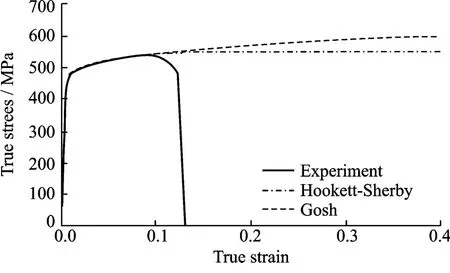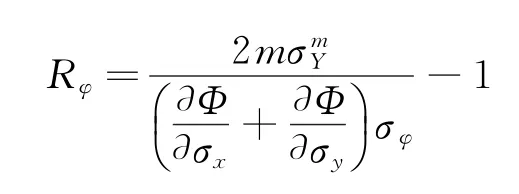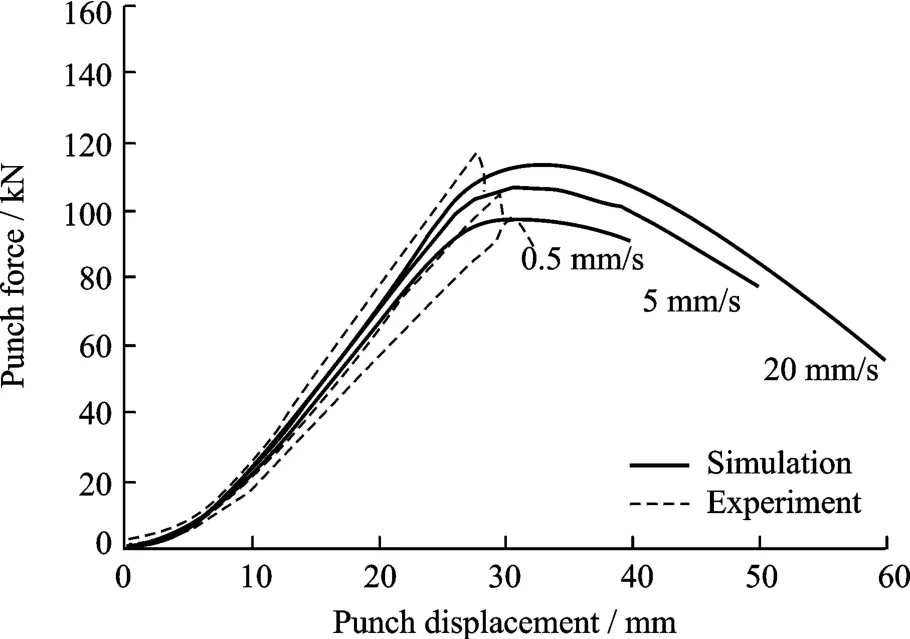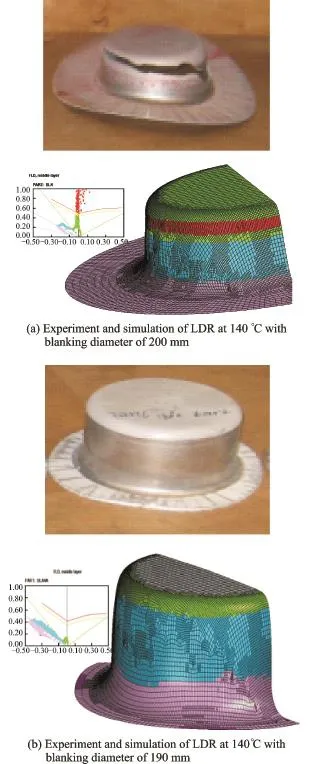Numerical Simulation of Warm Forming Behavior of High Strength Aluminum Alloy 7075
2016-12-01WangHuiYanDaweiLiangYangminXieGuoyin
Wang Hui,Yan Dawei,Liang Yangmin,Xie Guoyin
1.College of Mechanical and Electrical Engineering,Nanjing University of Aeronautics and Astronautics, Nanjing 210016,P.R.China;
2.Xi′an Aero-Engine(Group)LTD,Xi′an 710021,P.R.China
Numerical Simulation of Warm Forming Behavior of High Strength Aluminum Alloy 7075
Wang Hui1*,Yan Dawei1,Liang Yangmin2,Xie Guoyin2
1.College of Mechanical and Electrical Engineering,Nanjing University of Aeronautics and Astronautics, Nanjing 210016,P.R.China;
2.Xi′an Aero-Engine(Group)LTD,Xi′an 710021,P.R.China
Numerical analysis is critically important to understanding the complex deformation mechanics that occur during sheet forming processes.It has been widely used in simulation of sheet metal forming processes at room temperature in the automotive industry.However,material at elevated temperature behaves more differently than at room temperature and specific material parameters and models need to be developed for the simulation of warm forming.Based on the experimental investigation of material behavior of high strength aluminum alloy 7075 (AA7075),constitutive equations with strain rate sensitivity at 140,180 and 220℃are developed.Anisotropic yield criterion Barlat 89 is used in the simulation.Warm forming of limiting dome height tests and limiting draw ratio tests of AA7075 at 140,180 and 220℃are performed.Eorming limit diagrams developed from experiment at several elevated temperatures in the previous study are used to predict the failure in the simulation results.Punch force and displacement predicted from simulation are compared with the experimental data.Simulation results agree with experimental results,so the developed material model can be used to accurately predict material behavior during isothermal warm forming of the AA7075-T6 alloy.
high strength aluminum alloy;warm forming;numerical simulation;material model
0 Introduction
Einite element analysis(EEA)has been widely used in automotive industry to predict deformation behavior during stamping operations[1].Use of these tools has dramatically shortened lead times to produce good die systems as well as to reduce the amount of try-out time required to reach a controlled forming process. An accurate material model is critical for accurate simulation of the forming process.Eor traditional forming processes,numerous material models have been developed and are available in commercial EEA codes[2].However,these EEA codes often do not offer highly specialized material models developed for specific materials and processes. The warm forming process which is essentially stamping with a die at elevated temperature has been shown to enhance the formability of aluminum[3,4].While some research has been conducted for the development of warm forming material models,most of this work focuses on AA5××× and AA6×××series aluminum alloys.Eor example,Nader Abedrabbo used YLD96 and YLD2000 in warm forming of 5×××,6××× and 3×××material[5,6]and Bogard characterized the flow stress behavior of AA5754 with the modified power law model[7].All these works have greatly improved the simulation technology of the warm forming process.
Eor some automotive structural parts,e.g. the B-pillar,high strength aluminum alloys can potentially be used to replace steel for weight reduction.Aluminum alloy 7075(Al-Zn-Mg-Cu)(AA7075)has wide applications in aircraft structural materials due to its high strength and low density[8,9].The conventional forming process of AA7075 part is forming annealed AA7075,followed by solution heat treating and then artificial aging.In most cases,this requires a secondary" calibration"process to fix the distortion due to the high temperature solution heat treat and quench process.Eor complicated deep draw parts,superplastic forming is often utilized[10-14]. Superplastic forming is a low speed,high temperature process that also requires a high temperature heat treatment and perhaps calibration step after forming.Both of these technologies are not well suited to the high volume production rates of the automotive industry.One process that may be suitable for automotive manufacturing is warm forming.This process is targeted at a temperature in which the formability of the alloy is expanded sufficiently to stamp complex parts while not too high to destroy the T6 temper.Previous studies focused on the experimental study of formability at different temperatures[15,16].The numerical simulation of the warm forming behavior of high strength aluminum alloys has not been fully explored.Eor optimization of the warm forming process of high strength aluminum,a suitable material model under warm forming conditions needs to be developed.A detailed experimental investigation on warm forming formability has been conducted in Part 1[17]of this research. In the paper,a material model based on the experimental data is developed for simulation of warm forming of high strength AA7075.The limit drawing ratio(LDR)test and the limit dome height(LDH)test are simulated and compared with the experimental data.
*Corresponding author,E-mail address:wh508@nuaa.edu.cn.
How to cite this article:Wang Hui,Yan Dawei,Liang Yangmin,et al.Numerical simulation of warm forming behavior of high strength aluminum alloy 7075[J].Trans.Nanjing Univ.Aero.Astro.,2016,33(5):620-625.
http://dx.doi.org/10.16356/j.1005-1120.2016.05.620
1 Constitutive Equation Development
Elow stress represents the size of the yield function during deformation[18].To accurately simulate the sheet metal forming process,an appropriate equation to describe the stress-strain relationship is required.The equation describing changes in the flow stress of the material depends on deformation conditions such as strain rate and temperature.Eor the isothermal warm forming processes,the temperature of the die and blank are kept constant during the process.Therefore, for the constitutive equation in isothermal warm forming,only strain rate is considered.As noted in Table 1 several equations have been used in describing the stress-strain relationship,such as, Ludwic equation,Swift equation,Ghosh equation,Voce and Hockett-Sherby equation,and so on.

Table 1 Constitutive equation for sheet metal forming
Ludwic and Swift equation can be included in Ghosh equation and Voce equation can be included in Hockett-Sherby equation.A simplified Gosh and Hockett-Sherby equation can be shown as follows

Stress-strain relationship from the experiment in Ref.[17]is used to fit the equation with a regression method.As shown in Fig.1,the Ghosh equation predicts a higher stress than Hockett-Sherby after the ultimate stress is reached[18].

Fig.1 Regression results of stress-strain relationship with different equations at 140℃
The stress-strain relationship not only depends on temperature,but also strain rate at elevated temperature.The Cowper-Symonds model is used in the paper to describe the strain rate sensitivity.The constitutive equation form can be shown as

A regression method is used in determination of the parameters in this equation.Table 2 gives the parameters of the Hockett-Sherby and the strain rate Cowper-Symonds equation at temperatures of 140,180 and 220℃.

Table 2 Constitutive equation parameters of AA7075-T6 at different temperatures
2 Yield Function
The three-parameter yield function presented by Barlat is one of the most accurate yield functions for aluminum alloys[19].It simultaneously accounts for yield stress and R value directionalities.The yield function for plane stress can be defined as

whereσYis the yield stress.K1,K2are given by

The anisotropic material constants a,c,h, and p are obtained through R0,R45and R90
烟头随着他的抽吸,映红了他两片薄薄的嘴唇和蒜头鼻下两个不规则的鼻孔,烟头亮开时看得很清楚,那嘴唇上竖着一排“1”字形的皱纹,三根鼻毛很闹心地探出鼻孔。

The anisotropy parameter p is calculated implicitly.According to Barlat and Lian the R value (width to thickness strain ratio)for any angleφ can be calculated from

whereσφis the uniaxial tension in theφdirection. This expression can be used to iteratively calculate the value of p.Letφ=45 and define a function g as

Erom tensile test experiments,the following anisotropic material can be tested and used to calculate the yield surface of Barlat89.An iterative search is used to find p value as a function of temperature.R values for various temperatures are shown in Table 3.

Table 3 Anisotropic parameters of AA7075-T6 at different temperatures
3 Numerical Analysis
Einite element simulations of LDH and LDR tests are conducted using the commercial software LS-DYNA 971.A model of the die and blank are shown in Fig.2.Hypermesh is used to create the finite element mesh,assign the boundary conditions and build the LS-DYNA input deck for the analysis.Only one-quarter of the geometry is modeled due to the symmetric boundary conditions.The constitutive equations and yield criterion shown in Sections 1 and 2 of the paper are used in the simulation.A friction coefficient of 0.06 is used in the simulation.

Fig.2 EEM model of LDH and LDR tests
Eor the LDH processes,a blank with diameter of 140 mm is used and the boundary of the side is restrained with binder force of 100 k N,so no material is drawn in.Eor the LDR processes, blanks with different diameters are used to determine the LDR value.
4 Results and Discussion
4.1 LDH

Fig.3 Simulation and experimental results of LDH at 180℃
Fig.4 shows a comparison between experimental and numerical results of the punch load v.s.punch depth at three elevated temperatures. As seen in the plot,the simulated punch forces agree well with the experimental results at 180 and 220℃.Eor the experiment performed at 140℃, specimens fractured earlier than the prediction from simulation.This may be a result of the material model′s inability to capture the fracture behavior at the lower temperature.

Fig.4 Punch force plotted as a function of displacement at different temperatures(punch speed= 5 mm/s)
To investigate the strain rate sensitivity,the LDH process at 180℃under different punch speeds is analyzed.Punch force and penetration curves are shown in Fig.5.Results indicate the simulation captures the strain rate effect.

Fig.5 Punch force plotted as a function of punch displacement for different forming speeds at 180℃
4.2 LDR
The LDR value is defined as the maximum blank diameter which can be formed without fracture divided by the diameter of the punch.Fig.6 shows both photographs of LDR samples and the corresponding simulation results for two different blank diameters at 140℃.Simulations are performed with a friction coefficient of 0.04.Results indicate that a blank diameter of 190 mm can be formed but a blank diameter of 200 mm fractures during forming.
Fig.7 shows the LDR values predicted from simulation and determined from experiment.Re-sults show that when the friction coefficient is 0.04,the experimental results agree with the predictions from simulation at a set temperature of 140℃.However,simulation results over-predict LDR at the same coefficient of friction at the higher temperatures of 180 and 220℃.When the friction coefficient is changed to 0.08,the simulation results at 180℃are much closer to the experimental results.This may be a result of the sensitivity of the LDR experiment to friction coefficient coupled with the temperature effect on the lubricant.To better understand the effect,more testing is required to better measure the friction coefficient as a function of temperature.

Fig.6 LDR in experiment and simulation

Fig.7 LDR values tested and predicted by simulation for two friction coefficients
5 Conclusions
A strain rate dependent anisotropic material model for finite element analysis of warm forming of AA7075 is implemented into the finite element code LS-DYNA.The Hockett-Sherby hardening law is used to predict the flow stress at elevated temperature and anisotropic yield model parameters at elevated temperature are developed.The processes used in both LDH and LDR tests are simulated with the developed model.Eorming limit diagrams developed from experiment at several elevated temperatures in a previous study are used to predict the failure in the numerical simulations.Simulation results accurately predicted the failure behavior of LDH and LDR tests indicate that this material model can be used to predict the material behavior of the AA7075-T6 alloy during isothermal warm forming.
Acknowledgement
The authors gratefully acknowledge the support of Luo Yingbing,Eriedman Peter and George Luckey from Eord Motor Company.
[1] CHUNG K,SHAH K.Einite element simulation ofsheet metal forming for planar anisotropic metals[J]. Int J Plast,1992,8(4):453-476.
[2] ABEDRABBO N,POURBOGHRAT E,CARSLEY J.Eorming of aluminum alloys at elevated temperatures—Part 2:Numerical modeling and experimental verification[J].Int J Plast,1996,22(2):342-373.
[3] TOROS S,OZTURK E,KACAR I.Review of warm forming of aluminum-magnesium alloys[J].J Mater Process Technol,2008,207:1-12.
[4] LI D,GHOSH A K.Biaxial warm forming behavior of aluminum sheet alloys[J].J Mater Process Technol,2004,145:281-293.
[5] ABEDRABBO N,POURBOGHRAT E,CARSLEY J.Eorming of AA5182-O and AA5754-O at elevated temperatures using coupled thermo-mechanical finite element models[J].Int J Plast,2007,23:841-875.
[6] ABEDRABBO N,POURBOGHRAT E,CARSLEY J.Eorming of aluminum alloys at elevated temperatures—part 1:Material characterization[J].Int J Plast,2006,22(2):314-341.
[7] BOOGAARD VAN DEN A H,HUETINK J.Simulation of aluminium sheet forming at elevated temperatures[J].Comput Methods Appl Mech Engrg, 2006,195(48):6691-6709.
[8] ELECK P,CALLEROS D,MADSEN D.Retrogression and reaging of 7075 T6 aluminum alloy[J].Mate Sci Eorum,2000,331:649-654.
[9] ZHAO Jun,ZHU Jianlong,XUE Huajuan,et al. Effects of anodizing methods on behavior of 7075 aluminum alloy[J].Journal of Nanjing University of Aeronautics and Astronautics,2008,40(3):412-416.(in Chinese)
[10]XUE Xiaobo,CHEN Minghe.Optimization of internal structure for aerofoil part manufactured by SPE/ DB[J].Journal of Nanjing University of Aeronautics and Astronautics,2012,44(S1):128-131.(in Chinese)
[11]ERIEDMAN P A,LUCKEY S G.Overview of superplastic forming research at ford motor company [J].J Mater Eng Perform,2004,13(4):670-677.
[12]WANG Y,MISHRA R S.Einite element simulation of selective superplastic forming of friction stir processed 7075 Al alloys[J].Mater Sci Eng A,2007, 463:245-248.
[13]MORRIS L R,GEORGE R A.Warm forming highstrength aluminum automotive parts:SAE#2005-01-1388[R].USA,SAE,2005.
[14]KRAJEWSKI P E.The warm ductility of commercial aluminum sheet alloys:SAE#2005-01-1388[R]. USA:SAE,2005.
[15]LEE W S,SUE W C,LIN C E,et al.The strain rate and temperature dependence of the dynamic impact properties of 7075 aluminum alloy[J].J Mater Process Technol,2000,100:116-122.
[16]HUANG Hua,LI Dayong,PENG Yinghong.Experimental study on the forming limit diagrams (ELD)of 7075 T6 aluminum alloy sheet at warm state[J].J Plast Eng,2010,17(1):93-97.(in Chinese)
[17]WANG Hui,LUO Yingbing,ERIEDMAN P,et al. Warm forming behavior of high strength aluminum alloy AA7075[J].Trans Nonferrous Met Soc China, 2012,22:1-7.
[18]GRONOSTAJSKI Z.The constitutive equations for EEM analysis[J].J Mater Process Technol,2000, 106:40-44.
[19]BARLAT E,LIAN J.Plastic behavior and stretchability of sheet metals,Part I:A yield function for orthotropic sheets under plane stress conditions[J].Int J Plast,1989,15:51-56.
Dr.Wang Hui received B.S.and Ph.D.degrees in College of Mechanical and Electrical Engineering from Nanjing U-niversity of Aeronautics and Astronautics in 2005 and 2011,respectively.Erom 2008 to 2010,he was a″exchange student″in Mechanical Engineering Department,U-niversity of Michigan,Ann Arbor,MI,USA.Erom 2011 to present,he has been in College of Mechanical and Electrical Engineering,Nanjing University of Aeronautics and Astronautics.His research is focused on metal forming and EEM simulation.
Mr.Yan Dawei is a graduate student in College of Mechanical and Electrical Engineering from Nanjing University of Aeronautics and Astronautics.His research is focused on sheet metal forming technology and relevant fields.
Mr.Liang Yangmin received B.S.degree in manufacture engineering from Northwest Polytechnical University.He is a senior director in Xi′an Aero-Engine(Group)LTD. His research is focused on specific manufacture engineering.
Mr.Xie Guoyin received B.S.degree in manufacture engineering from Taiyuan University of Technology.He is a senior engineer in Xi′an Aero-Engine(Group)LTD.His research is focused on numerical manufacture engineering.
(Executive Editor:Xu Chengting)
TG306 Document code:A Article ID:1005-1120(2016)05-0612-06
(Received 14 January 2015;revised 05 June 2015;accepted 20 June 2015)
杂志排行
Transactions of Nanjing University of Aeronautics and Astronautics的其它文章
- Dissolution Characteristics of New Titanium Alloys in Electrochemical Machining
- Model of Autonomous Positioning Through Associating Environment Memory Information
- Principle and Experimental Verification of Flexible Caudal Fin Based on Active Torsion Propulsion Mode
- Energy-Efficient Process Planning Using Improved Genetic Algorithm
- Design and Experimental Evaluation of PID Controller for Digital Electro-Pneumatic Cabin Pressure Control System
- Mission-Oriented Configuration Model of Aircraft Carrying Spares and Dynamic Optimization Policy
